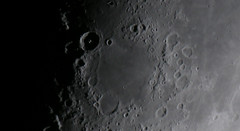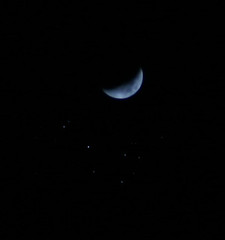THEOPHILUS.--The most northerly of three of the noblest ring-mountains on the visible surface of the moon, situated on the N.W. side of the Mare Nectaris. It is nearly 64 miles in diameter, and is enclosed by a mighty rampart towering above the floor at one peak on the E. to the height of 18,000 feet, and at two other peaks on the opposite side to nearly 16,000 and 14,000. The border, though appearing nearly circular with low powers, is seen, under greater magnification, to be made up of several more or less linear sections, which give it a polygonal outline. It is prominently terraced within, the loftier terraces on the E. rising nearly to the height of the crest of the wall, and including several craters and elongated depressions. On the E. glacis is a row of large inosculating craters; and near its foot, S.W. of Madler, a short unrecorded rill- valley. The magnificent bright central mountain is composed of many distinct masses surmounted by lofty peaks, one of which is about 6,000 feet above the floor, and covers an area of at least 300 square miles. Except a distinct crater on the S.E. quarter, this appears to be the only object within the ring.
Sunday, May 11, 2008
Friday, May 2, 2008
The Moon and Pleiades
The Pleiades, also known as M45, the Seven Sisters, SED, or Subaru (in Japan), is an open cluster in the constellation of Taurus. It is among the nearest star clusters, and is probably the best known, and is certainly the most obvious to the naked eye. It is sometimes referred to as the Maia Nebula, perhaps erroneously considering that the reflection nebulosity surrounding Maia is intrinsic.
The cluster is dominated by hot blue stars which have formed within the last 100 million years. Dust that forms a faint reflection nebulosity around the brightest stars was thought at first to be left over from the formation of the cluster, but is now known to be an unrelated dust cloud that the stars are currently passing through. Astronomers estimate that the cluster will survive for about another 250 million years, after which it will have dispersed due to gravitational interactions with its galactic neighborhood.
The cluster is dominated by hot blue stars which have formed within the last 100 million years. Dust that forms a faint reflection nebulosity around the brightest stars was thought at first to be left over from the formation of the cluster, but is now known to be an unrelated dust cloud that the stars are currently passing through. Astronomers estimate that the cluster will survive for about another 250 million years, after which it will have dispersed due to gravitational interactions with its galactic neighborhood.
Labels:
M45,
Maia,
Maia Nebula,
Pleiades,
SED,
Seven Sisters,
Subaru
Subscribe to:
Posts (Atom)

